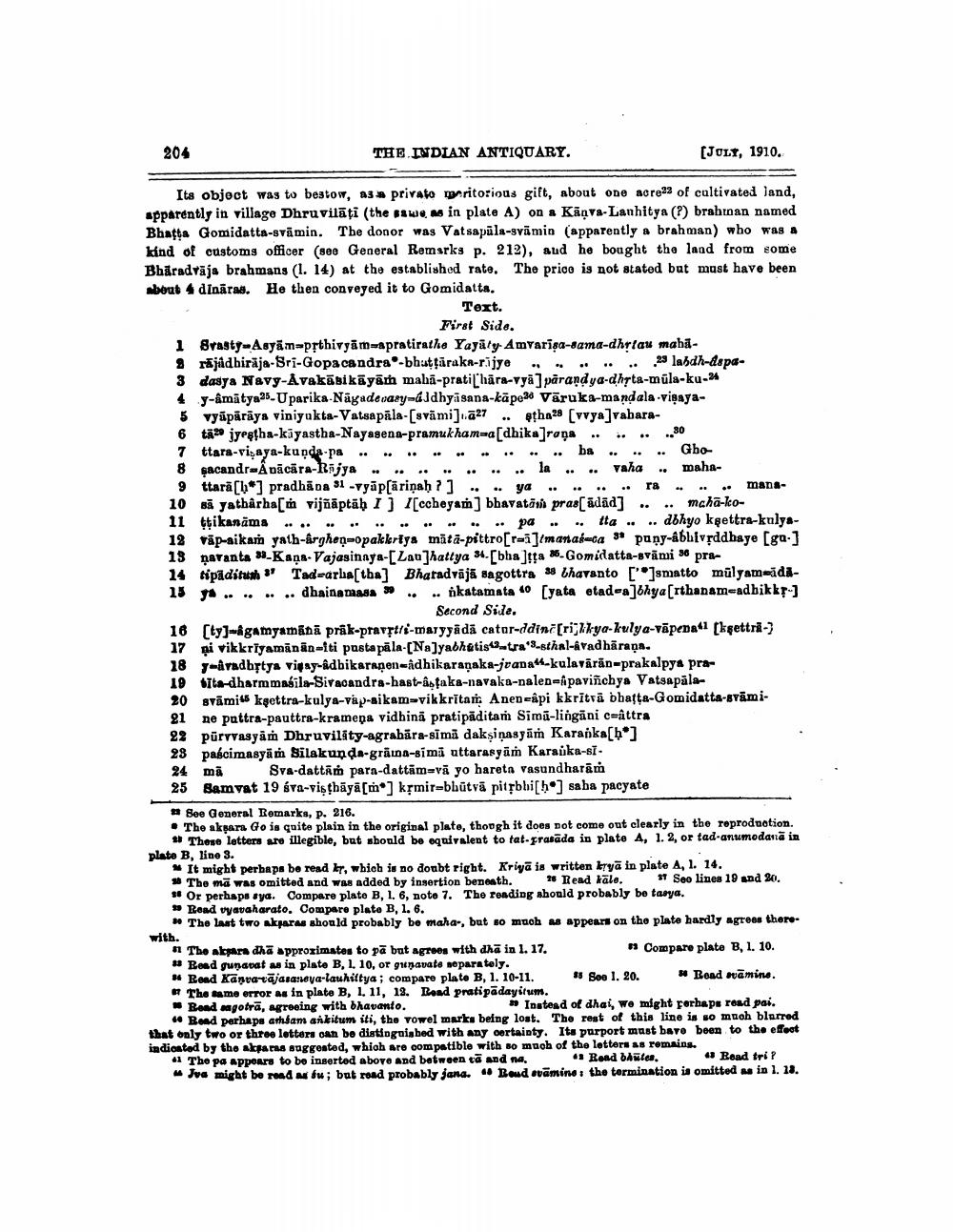________________
204
THE INDIAN ANTIQUARY.
(JOLT, 1910.
Its objoct was to bestow, as a privato writorious gift, about one acre22 of cultivated land, apparently in village Dhruvilāti (the swem in plate A) on a Kāņva-Lanhitya (?) brahman named Bhatta Gomidatta-svamin. The donor was Vatsapūla-svāmin (apparently a brahman) who was a kind of customs officer (800 General Remarks p. 212), aud he bought the land from some Bhiradvāja brahmans (1. 14) at the established rate. The prioo is not statod but must have been about 4 dināras. He then conveyed it to Gomidatta.
Text.
First Side. 1 Srasty-Asyäm=prthivyam-apratirathe Yayāty Amarisa-dama-dhrlau maha% răjidhiraja-Sri-Gopacandra-bhattaraka-rijye . . . .... 23 labdh-dspa3 dasya Navy-Avakākikāyām malā-prati["hāra-vyä]parandya-dhta-mula-ku-24 4 y-amatya25- Uparika-Nāgadewasy-ájdhyâsana-kāpe2Väruka-mandala-visaya5 vyūpäräys viniyakta-Vatsapāla-[svämi].727 .. etha28 (vvya]vabara6 tā jyratha-kāyastha-Nayasena-pramukham=a[dhika]roņa .. . .. ..80 7 ttara-vişaya-kunda-pa ................. ba ...... Gbo8 pacandr-Ånācāra-Rajya .. .. .. .. .. .. .. la .... vaha .. maha
ttară[ho] pradhāna 31 - vyāplāriņaḥ?] .. .. ya .. .. .. .. ra .... mana10 sã yatharha[vijñāptäh 1 ] T[ccheyan) bhavatási pras(ādād] .. .. mcha-ko11 tikanāma ... .. .. .. .. .. .. .. .. pa .... ta .... dbhyo kgettra-kulya12 vāp-aikar yath-arghen-Opakkeriya mātā-pittro[ra]imanagata 31 puny-abhivrddhaye [ga] 13 nayanta Kaņa-Vajasinnya-[Laulhattya 84.[bhatta *-Gomidatta-svami 36 pra14 nipaditush" Tad-arlatba) Bharadvājā sagottra 38 bhavanto [*]smatto mülyam-ida13 .. .. .. .. dhainamasa 3 ... nkatamata 0 [yata etad-a]bhya[rthanam-adhikkm.)
Second Side. 16 [ty]-gamyamanā prak-pravşti-marygādā cator-ddini [rijkkya-kulya-vāpenas [kettri-> 17 i vikkriyaminaawiti pasta pāla [Na]yabhatis4.tra'-sthal-Avadharaṇa. 18 yivadbftya vigay-adbikaranen=adhikarasaka-jvana" kulaväran-prakalpya pra19 dita-dharmmabila-Siracandra-hast-astaka-navaka-nalen-fpaviñchya Vatsapāla20 Bvāmi kgettra-kulya-vap-aikam-vikkrītart. Anen-api kkritrā bhatta-Gomidatta-svämi21 no puttra-pauttra-kramena vidhină pratipăditan Sima-lingani cwattra 22 pürrvasyam Dhruvility-agrabăra-simi daksinasyan Karanka[bo] 28 pabcimasyi Silakanda-grauna-simi uttarasyum Karaúka-sl. 24 m Sva-dattam para-dattām=rä yo hareta vasundharam 25 Bamvat 19 éva-Vişthāyā[m] krmir-bhūtvā pitřbbi[ho] saba pacyate
Bee General Remarks, p. 216. • The akrar Go is quite plain in the original plate, though it does not come out clearly in the reproduction.
# These letters are illegible, but sbould be equivalent to tat-grasāda in plato A, 1.2, or tad arumodanta in plate B, line 3.
It might perbapa bo read ly, which is no doubt right. Krijā is written bryā in plate A, l. 14.
The mā was omitted and was added by insertion beneath. Read Kale. Soo lines 19 and 20. # Or perhaps sya. Compare plate B, 1. 6, noto 7. The reading should probably be tasya. * Read vyavaharato. Compare plate B, 1. 6.
# The last two skarns should probably be maha-, but so much as appears on the plate hardly agrees there with. n The skana dha approximates to pā but agrees with dha in l. 17.
Compare plate B, 1. 10. # Read gunavat as in plate B, 1, 10, or unavate separately. # Read Kanvarājana:reya-lauhiltya; compare plate B, 1. 10-11. " Seo I. 20. Bead māmine. # The same error as in plate B, 1, 11, 13. Read Pratipadayitum. Rond magotrā, agreeing with bhavanto.
Instead of dhai, we might perhaps road pai. · Bond perhaps arbam akitum iti, the vowel marks being loat. The rest of this line is so much blurred that only two or three letters can be distinguished with any certainty. Its purport mast bavo been to the effect indicated by the alpars suggested, which are compatible with so much of the letters as remains. • The pa appoars to be inserted above and between ta and na.
Rond bawla
Road tri? Jve might be rond stu; but rond probably jana. Boud svamine the termination is omitted in l. 13.




